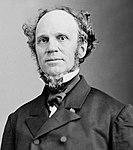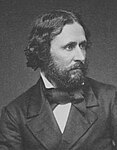Talk:The Guns of the South
| This is the talk page for discussing improvements to the The Guns of the South article. This is not a forum for general discussion of the article's subject. |
Article policies
|
| Find sources: Google (books · news · scholar · free images · WP refs) · FENS · JSTOR · TWL |
| This article is rated Start-class on Wikipedia's content assessment scale. It is of interest to the following WikiProjects: | |||||||||||||||||||||||||||||||||||||||||||
| |||||||||||||||||||||||||||||||||||||||||||
Large portion of North Carolina?"[edit]
It is unclear how large an area is occupied. But from Mollie's statement that it is three or four miles to Rivington from the point where the initial advance after Pleasants' explosion stalls, I would be generous and put Rivington in the middle of a ten mile radius. That still is small by North Carolina standards. To say "large portion" of the state implies occupation, say, from Wilmington to Raleigh.--Wehwalt 02:25, 12 June 2006 (UTC)
- It's not a very large area at all. If you've read the book, which includes a map, and are familiar with the area, the fictional town of Rivington is located roughly in the same spot as the actual town of Whitakers, North Carolina, about 10 miles north of Rocky Mount. The real town of Nashville, where Nate Caudell lives in the book, is six miles west of Rocky Mount. This entire section of the book takes place in Nash County, North Carolina. Jsc1973 (talk) 20:14, 6 May 2011 (UTC)
With the technology of the time, primarily walking everywhere with occasional horses, even ten miles is almost a days journey, as mentioned within the book. Even longer, when you consider the circumstances (An army which has slow communication, physical obstacles, etc.). While not really that geographically large of an area, it's large in the sense that the land is not traversed without great effort and time. However, I concede that even taking a long time to cross doesn't mean it's a large portion, and I'm not going to push to change it back. JBK405 04:10, 21 June 2006 (UTC)
Yes, but it was overrun the same day as the explosion . . . really, I think that Turtledove did not well plot the second half of the book. What was the Rivington men's game plan if they HAD killed Lee? And why would they stay around in the past once they were surrounded? Did they seriously expect to hold off Forrest forever?--Wehwalt 18:50, 22 June 2006 (UTC)
They needed a tank, Apache helicopter, or couple of Davey Crockett small scale nukes to hold off the South.Chris-marsh-usa (talk) 05:39, 3 April 2010 (UTC) Why didn't the Confederacy invent a sort of tank of its own from the knowledge of train engines and knowledge of artillery?Chris-marsh-usa (talk) 05:42, 3 April 2010 (UTC)
To be honest, I've wondered about the assassination plan myself, I really don't see any way for them to have taken control even with Lee dead. I get them staying in the past, they still wanted to take control of the Confederacy, and I think they really could have held off of the army for months, if not years (Nothing made any progress against their lines and they didn't lose any ground until the tunnel), but I don't quite see what possible plan they could have had. JBK405 21:05, 22 June 2006 (UTC)
It didnt make a lot of sense. They could easily have taken out Lee by sniper fire, and have had the advantage of deniability. And so they send a few men, even armed with Uzis, into a crowd which thinks gun control is how you make sure you are accurate? Not even covering fire from their building? And agreed, they could control a limited perimeter, but there is an awful lot of land between there and Richmond, or for that matter, Raleigh. Thez didnt have enough men to engage in conquest.--Wehwalt 20:02, 23 June 2006 (UTC)
Plot summary[edit]
The plot summary had been very, very long for some years, after the addition of a long, blow-by-blow account to an early revision. I've trimmed it back using an earlier revision. [1]. --Tony Sidaway 19:29, 10 February 2008 (UTC)
Whose revision?[edit]
I can't blame whoever for getting carried away but that was a heckuva anachronistic book. If you love anachronisms (things out of place and how famous people would marvel at them) you'll have to have this book. I know I got carried away describing The Burning Mountain by Alfred Coppel.Chris-marsh-usa (talk) 05:37, 3 April 2010 (UTC)
Overcompensation?[edit]
I understand that a long, detailed plot exposition is unencyclopedic. But now it has been chopped to the point that the AWB men are referred to as "Rivington men", with no antecedent, so that the article reader may not even understand how they had based themselves in Rivington, N.C. 69.96.228.35 (talk) 13:13, 6 March 2011 (UTC)
Election Map Requests 10/18/2017[edit]
From two tables in the back of the book, we learn the results of two presidential elections. One is an alternate version of the 1864 US Presidential Election and the other is the 1867 Confederate States Presidential Election. While I got the information down on my sandbox, I wish I could add a map of the electoral votes from those two elections. Unfortunately, no such maps has been made (at least on either Wikipedia or Wikimedia) to my knowledge. To anyone who sees this request, could you please attempt to make the two maps of the election results. I will list the information below containing which candidates won electoral votes from whatever state they carried below. I wish anyone who decides to make this map good luck!
United States presidential election, 1864 results from the novel[edit]
The states that voted for Democratic candidate Horatio Seymour and his running mate Clement Vallandigham were New York (33), Pennsylvania (26), Ohio (21), Indiana (13), Kentucky (11), Missouri (11), Wisconsin (8), Maryland (7), Oregon (3), and California (5). He won the election and carried these ten states with 138 electoral votes.
The states that Republican incumbent President Abraham Lincoln and incumbent Vice President Hannibal Hamlin were Maine (7), New Hampshire (5), Vermont (5), Massachusetts (12), Rhode Island (4), Connecticut (6), Michigan (8), West Virginia (5), Illinois (16), Minnesota (4), Iowa (8), and Nevada (3). Lincoln came in second place and carried 12 states with 83 electoral votes.
The other two candidates that were known to win states were Radical Republican John C. Frémont and his running mate Andrew Johnson, who only won three electoral votes from Kansas and Independent George McClellan and his running mate Edward Everett, who only won 10 electoral votes from Delaware (3) and New Jersey (7).
Confederate States presidential election, 1867 results from the novel[edit]
The states that voted for Confederate Party nominee Robert E. Lee and his running mate Albert Gallatin Brown are Florida (4), Georgia (12), Kentucky (14), North Carolina (12), Tennessee (14), and Virginia (13). Lee and Brown carried 69 electoral votes from these six states.
The states that voted for Patriot Party nominee Nathan Bedford Forrest and his running mate Louis Wigfall are Alabama (11), Arkansas (6), Louisiana (8), Mississippi (9), South Carolina (8), and Texas (8). Forrest and Wigfall received 50 electoral votes from these six states.
--JCC the Alternate Historian (talk) 14:30, 18 October 2017 (UTC)
 Done Well, never mind to that. JerrySA1 was able to create both maps and I added them to the article. --JCC the Alternate Historian (talk) 21:00, 25 August 2019 (UTC)
Done Well, never mind to that. JerrySA1 was able to create both maps and I added them to the article. --JCC the Alternate Historian (talk) 21:00, 25 August 2019 (UTC)
Election Infoboxes[edit]
As both the 1864 United States presidential election and the 1867 Confederate States presidential elections get referenced in the book with a good amount of details, I figured that some election infoboxes consiting of the two elections would be a good idea. Info will be posted below. --JCC the Alternate Historian (talk) 21:45, 17 December 2019 (UTC)
1864 United States presidential election[edit]
| |||||||||||||||||||||||||||||||||||||||||||||||||||||||||||||
All 234 electoral votes of the Electoral College 118 electoral votes needed to win | |||||||||||||||||||||||||||||||||||||||||||||||||||||||||||||
|---|---|---|---|---|---|---|---|---|---|---|---|---|---|---|---|---|---|---|---|---|---|---|---|---|---|---|---|---|---|---|---|---|---|---|---|---|---|---|---|---|---|---|---|---|---|---|---|---|---|---|---|---|---|---|---|---|---|---|---|---|---|
| |||||||||||||||||||||||||||||||||||||||||||||||||||||||||||||
 The results of the 1864 United States presidential election mentioned in the novel. The blue states are those won by Seymour/Vallandigham, the red states won by Lincoln/Hamlin, light gray states won by McClellan/Everett, yellow states won by Fremont/Johnson while dark gray represents the US territories. | |||||||||||||||||||||||||||||||||||||||||||||||||||||||||||||
| |||||||||||||||||||||||||||||||||||||||||||||||||||||||||||||
The 1864 United States presidential election, the 20th quadrennial presidential election, was held on Tuesday, November 8, 1864. In the aftermath of the Second American Revolution, Democratic candidate, former Governor of New York Horatio Seymour narrowly defeated incumbent President Abraham Lincoln of the Republican Party, by a narrow margin of 138–83 in the electoral college, with 41.5% of the popular vote. Two other candidates, Radical Republican John C. Frémont and Independent George B. McClellan also ran in the election and received small amounts of the popular vote.
1867 Confederate States presidential election[edit]
| |||||||||||||||||||||||||||||
| |||||||||||||||||||||||||||||
 The results of the 1867 Confederate States presidential election in the novel. The Red denotes states won by Lee/Brown, blue denotes those won by Forrest/Wigfall while dark gray represents the Indian Territory. | |||||||||||||||||||||||||||||
| |||||||||||||||||||||||||||||
The 1867 Confederate States Presidential Election was the second sextennial presidential election, held on November 5, 1867. It set the stage for the path of the country going forward, particularly as regards to slavery. Two new parties were born, the Confederate Party of General Robert E. Lee and his running mate Albert Gallatin Brown and the Patriot Party of Nathan Bedford Forrest and his running mate Louis Wigfall.
Campaign[edit]
During the campaign Forrest went on the stump around the Confederacy, while Lee remained at home. Until election day, Lee felt sure he would win. Forrest ran for president on the platform to continue slavery, while Lee promised to ease restrictions against blacks. Lee also went soft-line on the United States and made use of various issues, while Forrest just kept to his platform.
Election Results[edit]
The election came to ride on Tennessee with the Electoral College tied down 55-50 (60 were required for election). Eventually, several days after the election, Lee would win the College 69-50 and the popular vote 496,536 to 466,901.
Lee won the six states of Florida (4), Georgia (12), Kentucky (14), North Carolina (12), Tennessee (14), and Virginia (13).
Forrest won the six states of Alabama (11), Arkansas (6), Louisiana (8), Mississippi (9), South Carolina (8) (who's electors were chosen by the state legislature rather than by popular vote), and Texas (8).
- Start-Class novel articles
- Mid-importance novel articles
- Start-Class Military fiction task force articles
- Unknown-importance Military fiction task force articles
- Start-Class Science fiction novels articles
- Unknown-importance Science fiction novels articles
- Novel has incomplete Book infobox
- WikiProject Novels articles
- Start-Class United States articles
- Mid-importance United States articles
- Start-Class United States articles of Mid-importance
- Start-Class American Civil War articles
- American Civil War task force articles
- American Civil War articles needing attention
- United States articles needing attention
- WikiProject United States articles













